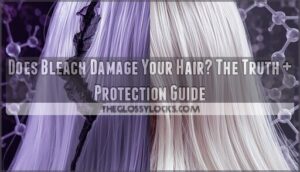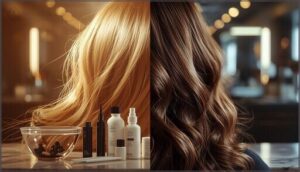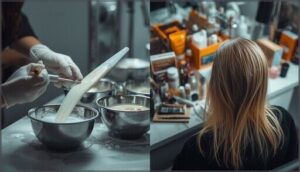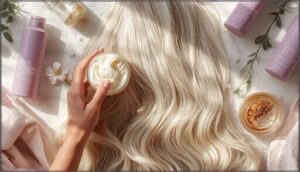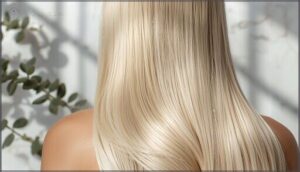This site is supported by our readers. We may earn a commission, at no cost to you, if you purchase through links.
Your colorist mixes the bleach, and you watch in the mirror as they section your hair, knowing that platinum transformation comes with a price. Yes, bleach damages your hair—it’s not a matter of if, but how much. The chemical process permanently alters your hair’s internal structure by breaking down the disulfide bonds that give strands their strength, which increases porosity by 40-60% and can reduce tensile strength by up to 30%. You’ll notice the effects through increased breakage, persistent frizz, and that unmistakable rough texture that no amount of smoothing serum seems to fix.
Understanding exactly what bleach does to your hair and how different factors—from developer strength to your hair’s starting condition—influence the damage puts you in control. The good news: strategic preparation and targeted aftercare can minimize structural compromise and keep your bleached hair healthier than you might expect.
Table Of Contents
- Key Takeaways
- Does Bleach Damage Your Hair?
- Factors That Influence Bleach Damage
- How to Minimize Hair Damage When Bleaching
- Essential Aftercare for Bleached Hair
- Long-Term Hair Health After Bleaching
- Frequently Asked Questions (FAQs)
- How long does it take for hair to recover between bleach sessions?
- What are some common hair concerns after bleaching?
- What are the supplies needed for toning hair silver?
- Can bleached hair return to its natural color?
- Does bleach affect hair growth from the roots?
- What nutrients help strengthen hair after bleaching?
- Are there alternatives to bleach for lightening hair?
- How does water quality impact bleached hair maintenance?
- Conclusion
Key Takeaways
- Bleach permanently damages hair by breaking down disulfide bonds, increasing porosity by 40-60% and reducing tensile strength by up to 30%, which means structural compromise is unavoidable but manageable with proper care.
- Professional bleaching reduces damage risk by 40-60% compared to DIY attempts, with salon colorists achieving 95% higher color accuracy and 72% less scalp irritation through custom formulations and precise timing.
- Strategic aftercare with bond-building treatments applied within the first week can boost tensile strength by 12% and reduce breakage by 18%, while deep conditioning twice weekly and limiting heat styling to twice per week protects recovering strands.
- Hair requires 6-8 weeks between bleach sessions to restore 50-70% of moisture balance, and skipping this recovery window increases breakage risk by 30-50%, making patience essential for maintaining long-term hair health.
Does Bleach Damage Your Hair?
Yes, bleach does damage your hair—there’s no way around it. The process chemically alters your hair’s structure, and the extent of that damage depends on several factors you can control.
Let’s break down what’s actually happening to your strands, what warning signs to watch for, and why the person holding the bleach bottle matters more than you think.
How Bleach Affects Hair Structure
Bleach penetration isn’t just surface-level—it oxidizes the disulfide bonds in your hair structure, permanently altering the cortex and cuticle. This chemical reaction increases hair porosity by 40–60%, while cuticle damage lifts protective scales and reduces tensile strength by 10–30%.
The result? Cortex weakening that makes your strands vulnerable to fiber breakage and moisture loss, fundamentally changing how your hair behaves.
Common Signs of Bleach Damage
Your hair will tell you when bleach damage has taken hold—watch for increased hair porosity, visible cuticle damage, and breakage rates climbing by 20–30%. Split ends, persistent frizz control issues, and strands that snap under minimal tension signal structural compromise.
If your hair feels brittle, tangles constantly, or shows rough texture after bleaching, you’re seeing the measurable effects of bleach your hair undergoes during chemical processing.
Risks of DIY Vs. Professional Bleaching
When you tackle a bleach job at home, you’re facing 41% higher odds of uneven lightening that’ll need professional correction within two weeks. DIY attempts show 28% more over-processing risk, while salons reduce scalp irritation by 72% through proper scalp protection and bleach safety protocols.
- Chemical irritation strikes 14% of at-home bleachers within 72 hours, requiring topical treatment
- Damage control suffers when only 21% of DIYers perform strand tests, versus 95% of professionals
- Professional guidance delivers 15 points higher satisfaction scores after six months of bleach hair damage monitoring
- At-home hair bleaching leads to breakage and porosity issues that professional hair care prevents through custom formulations
Factors That Influence Bleach Damage
Not all bleach jobs are created equal. The amount of damage you’ll see depends on a few key factors, from the condition of your hair before you even open the bleach to how you handle the application itself.
Let’s break down what really makes the difference between a healthy transformation and a hair disaster.
Hair Health Before Bleaching
Think of your starting point as the foundation of your entire transformation. Hair porosity, moisture levels, and cuticle integrity directly determine how your strands respond to bleach.
Well-conditioned hair with strong protein content and proper scalp preparation can handle lightening with far less damage. You’re giving yourself a fighting chance when you invest in hair health before the process begins.
Importance of Developer Strength and Timing
Developer strength and bleach timing control everything from color lift to lasting damage. High-volume peroxide—30 to 40 volume—lifts faster but can triple breakage risks if left on beyond 45 minutes, while 10 to 20 volume works slower with less cuticle damage.
Your processing time matters:
- 20 to 40 minutes is the safe processing window for most bleach jobs
- 30 volume developer achieves up to 60% faster melanin oxidation
- Prolonged exposure raises hair porosity by 15 to 35% within a week
- Alkaline pH above 9 swells cuticle scales by 25 to 40%
- Professional timing adjustments reduce elasticity loss by 20 to 35%
Skilled colorists adjust developer and processing time based on your hair porosity and target lift, protecting your strands while delivering the transformation you want.
Impact of Repeated or Aggressive Bleaching
Every bleach session stacks damage. Tensile strength drops 25 to 40% after repeated processing, and breakage risk climbs 30 to 60% over five cycles. Cuticle health deteriorates, protein loss accelerates, and hair porosity spikes 20 to 35%, making strands fragile and prone to snapping.
Repeated bleaching stacks damage—tensile strength drops up to 40%, breakage risk doubles, and strands grow fragile after just five cycles
Aggressive bleaching multiplies chemical damage, so spacing sessions six to eight weeks apart is critical for bleach recovery and hair damage prevention.
How to Minimize Hair Damage When Bleaching
Bleaching doesn’t have to wreck your hair if you take the right steps. The key is preparing your strands before you even touch the bleach and knowing when to hand the job over to a professional.
Here’s how to protect your hair and get the results you want without the damage.
Pre-Bleach Preparation and Hair Conditioning
Strong hair takes the hit better than weak strands. In the weeks before your bleach appointment, layer on moisture treatments and deep conditioning masks to fortify your cuticle.
Bond building products prep your internal structure, while leaving hair unwashed the day of creates scalp protection through natural oils.
This hair care routine isn’t optional—it’s your first line of defense to minimize damage and maintain hair health.
Benefits of Professional Colorists Vs. At-Home Kits
Professional colorists deliver up to 95% higher color accuracy than at-home kits, thanks to expert guidance on developer strength, timing, and hair-specific techniques.
Salon data shows damage prevention improves by 40–60%, with fewer breakage incidents and better cuticle integrity.
At-home hair bleaching carries higher risk—wrong formulas or processing times turn hair into straw, while professional hair coloring protects your investment.
Essential Aftercare for Bleached Hair
Once the bleach is rinsed out, the real work begins. Your hair needs intentional care to rebuild what the bleaching process stripped away, from broken bonds to lost moisture.
Here’s how to protect and restore your bleached hair so it stays strong, soft, and healthy.
Bond-Building and Repair Treatments
Think of bond-building treatments like architectural reinforcement for your hair—they reconnect broken disulfide bonds deep within each strand. Products containing keratin or cysteine can boost tensile strength by 12%, reduce breakage by up to 18%, and restore structural integrity when applied within the first week after bleaching.
Professional-grade formulas like Olaplex consistently outperform drugstore options in fiber strengthening and damage reversal, delivering measurable protein restoration that transforms compromised strands back toward their pre-bleach resilience.
Deep Conditioning and Moisture Restoration
Bleached hair drinks up moisture—up to 4% more water than untreated strands—making deep conditioning masks your most powerful repair tool.
Apply hydration therapy twice weekly to seal the cuticle and restore protein balance, choosing glycerin-rich formulas that maintain tensile strength while preventing brittleness.
Overnight treatments smooth roughness by 25%, transforming parched, damaged hair into softer, healthier strands that reflect light beautifully.
Protective Styling and Heat Management
Once you’ve rebuilt moisture, your next battle is against daily wear. Heat styling above 350°F causes up to 40% more cuticle damage, so limit sessions to twice weekly and always apply thermal protection products first.
Protective styling and heat management work hand-in-hand:
- Air-dry to 80–90% before applying any heat tool
- Section hair into 8–12 parts to avoid over-processing vulnerable areas
- Choose satin pillowcases to cut friction-related breakage by 10–15%
Gentle handling preserves your hard-won repair.
Long-Term Hair Health After Bleaching
Bleached hair doesn’t heal the way skin does, but you can absolutely improve its strength and appearance with the right approach. Your timeline for recovery depends on how damaged your hair is, plus how well you maintain it moving forward.
Let’s break down what to expect, how to protect your results, and when it’s time to call in a professional for help.
Recovery Timeline for Damaged Hair
Patience becomes your greatest ally when you’re managing bleach hair damage. Most damaged hair shows early signs of recovery within 1–2 weeks with the right repair treatments, but you’ll see meaningful hair restoration in 6–12 weeks.
Mildly damaged strands often bounce back in several weeks, while severe hair breakage may require several months.
Regular damage assessment and targeted hair health and maintenance speed up your recovery phases considerably.
Maintaining Results and Preventing Breakage
Once your strands show improvement, consistent hair health and maintenance protects your investment. Keep up bond-building treatments weekly to reduce hair breakage by 20-35%, pair them with protein reconstructors, and skip aggressive heat styling.
Your post-bleach care routine—deep conditioning masks, heat protectant sprays, and gentle detangling—becomes your damage control method arsenal, keeping breakage reduction techniques front and center for long-term hair repair success.
When to Seek Professional Help for Hair Repair
Even solid routines hit a wall. If your hair snaps when wet, won’t hold moisture after weeks of treatment, or shows bald patches, you need professional intervention—68% of salons report clients seeking expert damage assessment after breakage.
Timely restoration techniques can speed recovery by 35%, while delaying beyond two weeks raises your risk of irreversible hair damage by 19%. Don’t gamble with hair loss causes you can’t reverse at home.
Frequently Asked Questions (FAQs)
How long does it take for hair to recover between bleach sessions?
Your hair needs 6–8 weeks between bleach sessions to restore 50–70% of its moisture balance and rebuild strength. Skipping this window increases breakage risk by 30–50%, compromising your transformation.
What are some common hair concerns after bleaching?
After bleaching, you’ll likely face Hair Breakage, Split Ends, Dryness Issues, Frizz Control challenges, and Color Fading. These Cosmetic Hair Damage signs—roughness rising up to 60%, moisture dropping 25–40%—demand Hair Damage and Repair strategies plus consistent Hair Health Tips for Minimizing Hair Damage.
What are the supplies needed for toning hair silver?
Achieving that coveted platinum finish requires proper tools: purple conditioner, silver shampoo, toner ingredients with violet pigments, developer strength around 10 volume, color brushes, and bleach powder—essential supplies for post-bleaching processes and hair bleaching techniques.
Can bleached hair return to its natural color?
Once you bleach your hair, those lightened strands won’t revert to their original shade—pigment restoration doesn’t occur.
Natural regrowth from healthy follicles brings back your unbleached hair color over time, requiring patience and proper hair rejuvenation practices.
Does bleach affect hair growth from the roots?
Chemical impact doesn’t alter your root growth rate or hair follicle health—bleach damage myth debunked. The bleaching process only affects existing strands; hair regeneration from follicles continues normally, regardless of how you bleach your hair.
Understanding the main topic and its related subtopics can help clarify complex information.
What nutrients help strengthen hair after bleaching?
Your hair needs protein intake, vitamin supplements rich in biotin and omega-3 benefits, plus antioxidant effects from vitamins C and E.
Amino acid therapy aids hair repair methods, restoring hair elasticity, moisture, and strengthening damaged strands.
Are there alternatives to bleach for lightening hair?
Yes, you can skip the harsh bleach job entirely. Natural lighteners like lemon juice, peroxide alternatives, gentle highlights, and color deposits through hair toning offer safer hair lightening without compromising your strands’ integrity during chemical hair processing.
How does water quality impact bleached hair maintenance?
Water hardness directly affects hair bleaching and maintenance. Minerals like calcium and magnesium reduce bleaching effectiveness, increase breakage, and accelerate color fade, while chlorine impact damages cuticles. Filtered rinses and pH balance improve results.
Conclusion
The next time you sit in that salon chair, you’ll know the answer to “does bleach damage your hair?” isn’t just yes—it’s how you respond that matters.
Armed with bond-building treatments, strategic timing, and proper moisture restoration, you’re not gambling with your hair’s integrity anymore.
You’re making an informed choice, protecting what matters, and proving that dramatic color transformations don’t require sacrificing healthy strands. Your platinum future looks considerably brighter now.

